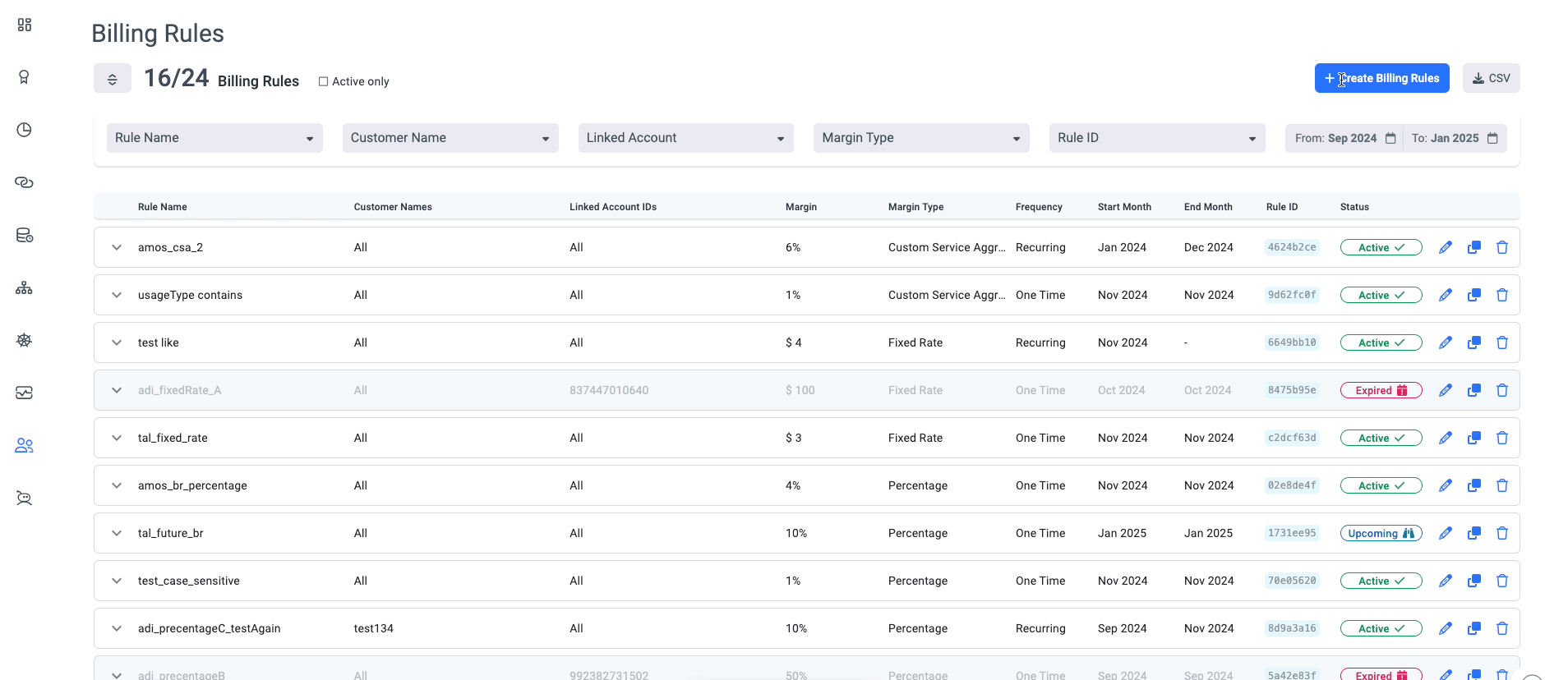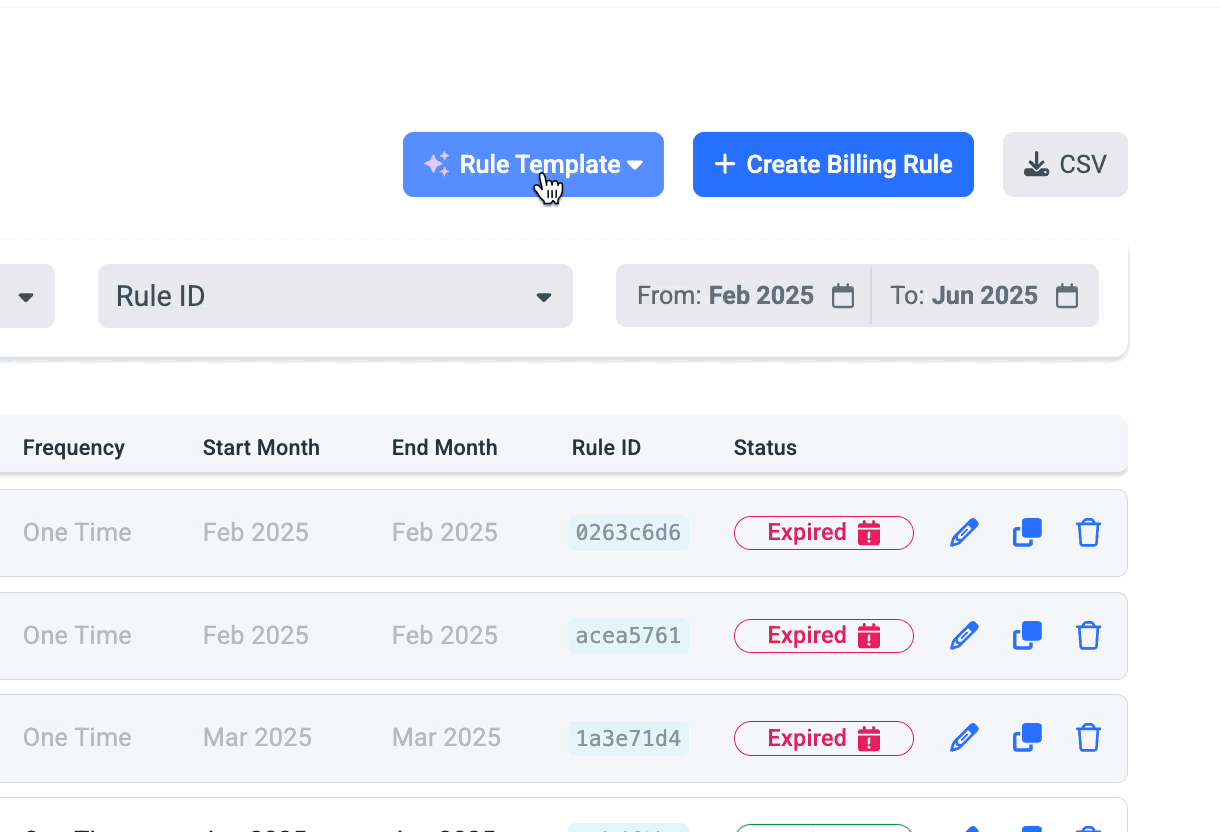Billing Rules
The Umbrella Cost Billing Rules capability is an essential part in the rebilling process and allows MSPs to define customized rules for AWS, Azure and GCP accounts, adjusting customer costs based on specific business logic.
Rules can be applied at the customer level or for specific linked accounts/subscriptions.
For each cloud provider (AWS/Azure/GCP) we offer unique filters to create detailed, flexible billing rules. These rules modify the costs visible to your customers, while you retain visibility into the original costs.

After creating or modifying a billing rule, the re-billing process must be executed to ensure the updated logic is applied to customer costs.
This article will cover the following sections:
- Billing Rule Margin Types
- Creating Billing Rules
- Managing Billing Rules
- Billing Rules Templates
- Billing Rules Preferences
Billing Rule Margin Types
Each margin type manipulates customer costs differently. Here are the available options:
1. Percentage:
Apply a percentage-based discount or increase on filtered costs from the partner pricing mode to the customer.
Example: For the partner, from the AWS Lambda costs of $1,000, apply a 6% increase. Meaning, the customer will see for this service $1,060.
Note: This margin type is available for AWS and Azure.
2. Fixed cost
Create a new service line with a specified charge/discount. You can name this service as it will appear to customers.
Example: Add a service named “MSP Discount” with a charge of -$250.
Note:
- For shared accounts, the custom service name will be visible for all of the customers under the shared account. However, the cost will be visible to the relevant customer only. Therefore, avoid specific naming for the custom service name, and provide a general name as the service should be.
- It will create a new service for the customer. It will appear on the first day of the month as a one-time charge/discount.
- This margin type is available for AWS and Azure.
3. Fixed Rate
Modify the rate of a specific line item (down to the resource level).
Example: Set the inter-AZ data transfer rate from $0.01/GB to $0.005/GB.
Note: This margin type is available for AWS and Azure.
4. Custom Service Aggregated %
Apply a discount/charge based on filtered costs, creating a new service line in Umbrella cost.
Example: From the customer on-demand costs ($10,000), apply a -15% discount. This will create a line item “MSP Discount” for -$1,500.
Note:
- For shared accounts, the custom service name will be visible for all of the customers under the shared account. However, the cost will be visible to the relevant customer only. Therefore, avoid specific naming for the custom service name, and provide a general name as the service should be.
- It will create a new service for the customer. It will appear on the first day of the month as a one-time charge/discount.
- This margin type is available for AWS and Azure.
5.AWS Support
Add a support charge according to the selected AWS support plan (e.g., AWS Support [Business]). You can choose to calculate support at the total customer cost level or per linked account.
Note:
- This margin type is available for AWS only.
- On the backend, we exclude by default the following from the calculation:
- cost_type = credit - Marketplace charges - service = Developer Support, Business Support, Enterprise Support, Premium Support.
6. Remove AWS Support
Remove an AWS support charge by selecting the appropriate plan.
Note: This margin type is available for AWS only.
7. Data Exclusion
Exclude specified records and data from customer visibility. The costs remain visible in Partner pricing mode.
Note: This margin type is available for AWS and Azure.

Creating Billing Rules
- Navigate to Partner > Billing Rules.
- Click on Create Billing Rule.
- Configure the rule settings on the left:
- Name and Description for the rule.
- Scope: Apply to the entire customer or a specific linked account/subscription.
- Frequency: One-time or recurring.
- Margin Type: Choose from the available margin types listed above.
Choose the relevant filters on the right to complete the rule logic. - Advance Setting (Optional for AWS): Select the cost measurement (e.g., Amortized Cost) on which the billing rule will be calculated—the resulting discount will be applied equally to all other cost measurements.
The rule changes will not immediately appear in customer costs; rebilling needs to run first (automatically occurs daily).
Managing Billing Rules
- Review and Filter Rules: Use the filters at the top to narrow down specific rules (e.g., by customer). For each rule, you can view its details and settings.
- Rule Options:
- Delete
- Edit
- Duplicate

Billing Rules Templates
Billing Rules Templates make it easier for MSPs to manage billing rules across multiple accounts in the same cloud. Instead of setting up the same rules over and over, you can now create a template rule that will be available to everyone in your organization and works across all accounts for a specific cloud provider.
How It Works
- Create a Billing Rule Template under any cloud account (e.g., AWS Account X).
- The template automatically becomes available for all AWS accounts and to all the users in your organization.
- Users can apply, tweak, and customize the template for each account as needed.
- If the template needs updates, just edit it once, and it’s ready to use everywhere.
Built-in System Templates
To save time, Umbrella also provides ready-to-use system templates for AWS, like EDP discounts. These give you a quick and standardized way to manage billing rules without starting from scratch.

Billing Rules Preferences
Multiple billing rules can apply to a single customer, and the order of calculation affects the final costs. You can set the order of the calculation based on the rule types (e.g., Fixed Costs, then Remove AWS Support) to ensure the calculation flow is accurate.
Setting Calculation Order:
- Go to Partner > Preferences.
- Select Billing Rules Prioritization.
- Drag and drop the Margin Types to set the desired calculation order.
- Click on Save.
Note: The order of rules on the Billing Rules page will follow this calculation order, with the first rule calculated appearing at the top.
Updated 6 months ago
